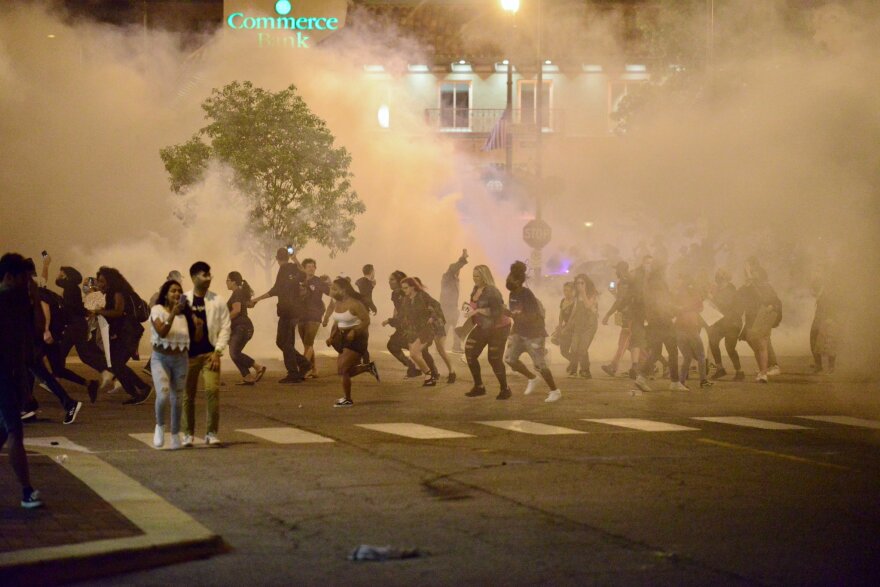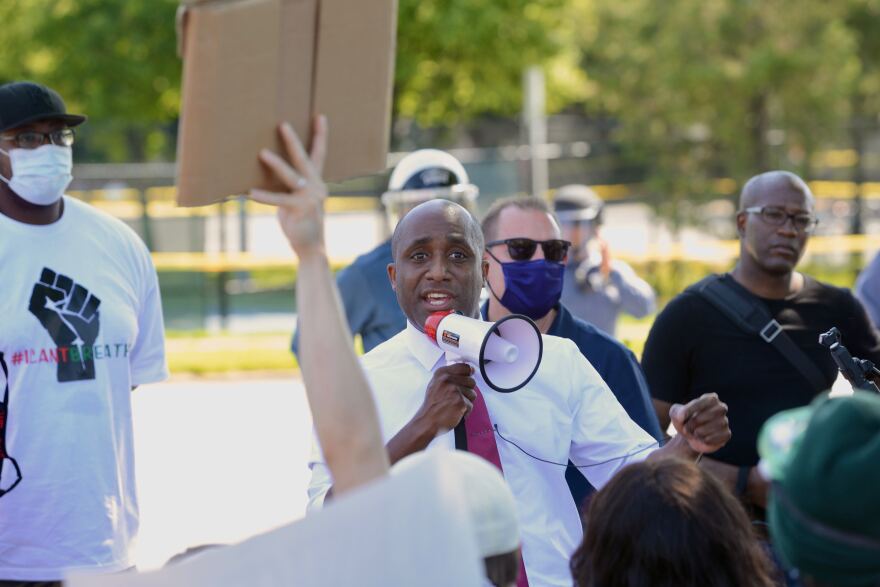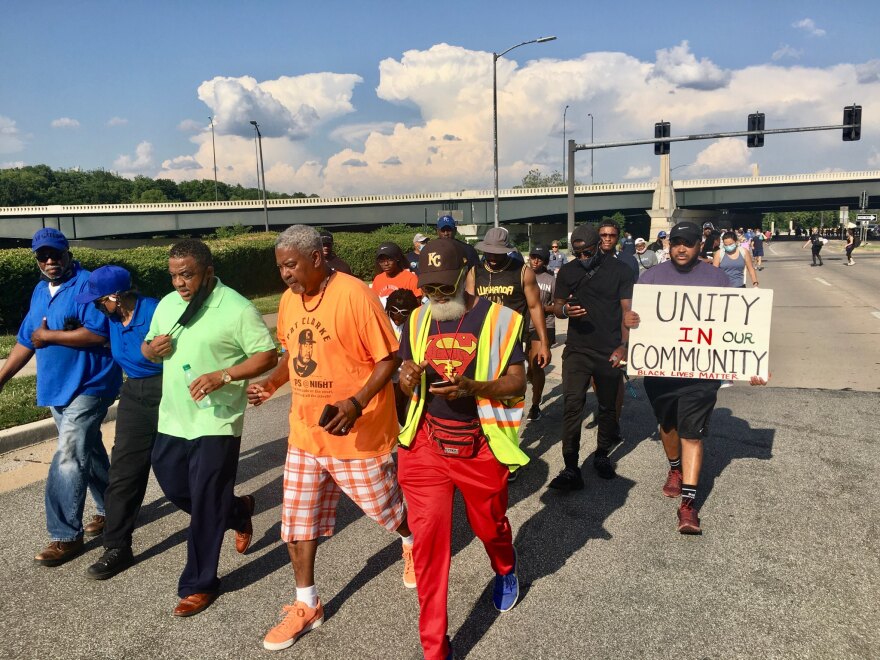The early protests against police brutality the weekend of May 29 in Kansas City were huge, with thousands of people and mostly peaceful. Some protesters tossed angry words at the police, but little else. That was by day.

Things amped up at night. Protesters took a more aggressive stance against the police. A few broke into bands, looting and vandalizing Country Club Plaza businesses. The crowds rained plastic water bottles and rocks down on police. Officers, in turn, fired rubber bullets and tear gas. It went back and forth like this for hours on end the first three nights of protesting.

“Yeah, they definitely came at us hardcore with the tear gas,” recalls protester Alexa Ward, walking away after hours of confrontation with the police. “That was a lot of gas, they just went nuts with it. Well, I guess it’s better... well, I would say it’s better than rubber bullets, but they’re using those too.”

One protester hit by a rubber bullet lost his eye. Police fired tear gas canisters, which also caused serious injuries, including at least one broken leg.
Police were hurt in the confrontations, too. The KCPD says a couple hundred police officers suffered bumps, burns and bruises. Something hurled from the crowd lacerated the liver of one officer.

Police made more than 200 arrests. Mostly for minor violations like refusing to an order to leave the street. But they weren’t the only ones keeping order.
Protesters aggressively self-policed their ranks, excoriating some hurling bottles at cops, berating those breaking windows.
There was a sense among protesters that a small minority of especially rowdy young men, many of them white, touched off most of the violence.
These are the suspects in the arson of a police car on the Plaza about 10 p.m. May 30. If you know who they are, you could get a cash reward by calling 816-474-TIPS. pic.twitter.com/cXxznZv4pS
— kcpolice (@kcpolice) June 10, 2020
Police detectives are still looking for a group of young white men, whom they believe set fire to a police car that first weekend. One of the suspects appeared to be wearing a shirt from a community college that’s in El Dorado, Kansas, two and a half hours south of Kansas City. Police also found two mysterious pallets of bricks in the Plaza, that no one has claimed, according to a Kansas City police spokesman.
And yet, Kansas City avoided the level of violence seen in many other cities that first weekend. And the demonstrations took on a different tone after the weekend.

“We go with the power of love tonight,” Pastor Brandon Mims told demonstrators on day 5 of the protests. “People expect you to act a fool, but we go with the power of love.”
Mims was among more than a dozen Black ministers out on the street that first Tuesday night of protests in Kansas City, encouraging order. The protests were still huge, and vigorous, but less combative.
The police were acting differently too, pulling back to the very edges of the demonstrations, chatting informally with protesters at times, not donning riot gear and forming solid defensive lines.
“We really were reflective every night about what we were doing and how we could make things better,” said Kansas City Police spokesman David Jackson. “One of the things that seemed to us was that we were kind of the objects of the protesters, and that maybe by lowering our presence, we’d lower the temperature.”
Between the protester self-policing, the calming presence of the pastors, and the change in police tactics, it worked. By Wednesday, June 3, Mayor Quinton Lucas and police chief Rick Smith were marching with protesters. Police set up shade tents to talk with demonstrators in one of the main streets the two groups fought over all weekend.

Demonstrators were making progress on some of their goals too. The police department announced it had money to buy body cameras, a long-standing demand.
Yohance Hubbard was hopeful that Kansas City had turned a corner.
“You see in other cities how things have gotten out of control," Hubbard said. “I think here the mayor has instilled a lot of trust in us to be peaceful. And so, I respect that. And I hope we honor that and stay peaceful.”
By the second week of protests, the demonstrations diverged somewhat along ideological lines.

The organization One Struggle KC held a demonstration at City Hall featuring a big banner painted to look bloody and bullet-torn, with a shredded upside-down American flag. The banner read “Abolish the Police, End Domestic Terrorism."
Organizer C.J. Pulliam said nothing short of revolution is called for.
“We're standing here today in our unapologetic blackness, not blackness that kneels with men who have ordered us tear gas, not blackness that gives agency to oppressors,” said Pulliam through a bullhorn.

At another rally the following week different Black activists, took a nearly opposite tack. Instead of going head-to-head against police, organizer Pat Clark urged Black citizens to cooperate with police investigations, to help disrupt a cycle of violence taking Black lives.
“I know Black Lives Matter ‘cause I'm a Black man living a Black life every day,” said Clark, addressing a crowd that included many uniformed police officers. “But when we start talking about other people taking our lives, then what's the conversation? Ain't nobody talking about us, killing us. Because if you can kill me, and I know you, my life never mattered to you in the first place.”

In Prairie Village, more than thousand people turned out, as Marshall Davis looked on.
"[This is] something should have happened years ago, but world turned a deaf ear as if they didn’t know that existed," Davis told the crowd. "Now the world has seen by virtue of what has happened to George Floyd. Now it’s coming to light. But for so many, like my nephew, it’s too late."
Davis’ nephew Ryan Stokes was unarmed when a Kansas City police officer killed him seven years ago.
Davis turns 78 Sunday. He was born in Alabama at a time when blacks had to step off the sidewalk for whites. In Kansas City, as a teenager, the police hit him and threatened to shoot him. Years later, he was pulled over and questioned in Johnson County, wearing his postal service uniform, just because he was black in a white part of town.

Still, last week, surveying the mostly white Johnson County crowd, Davis allowed a glimmer of hope.
"This is an indication that the possibilities are there now. But this is today. Today everybody’s out here because it’s fresh on their minds."





